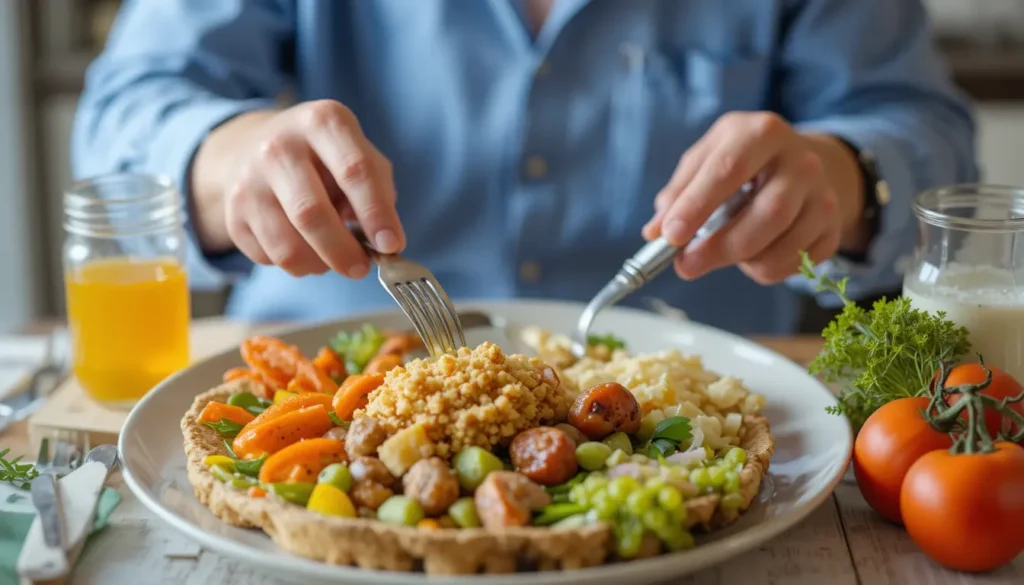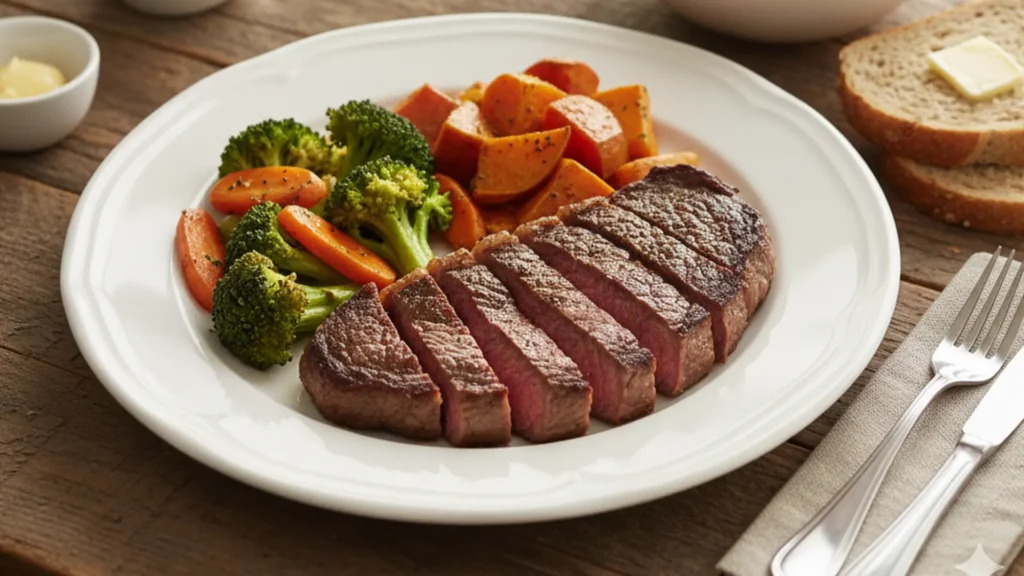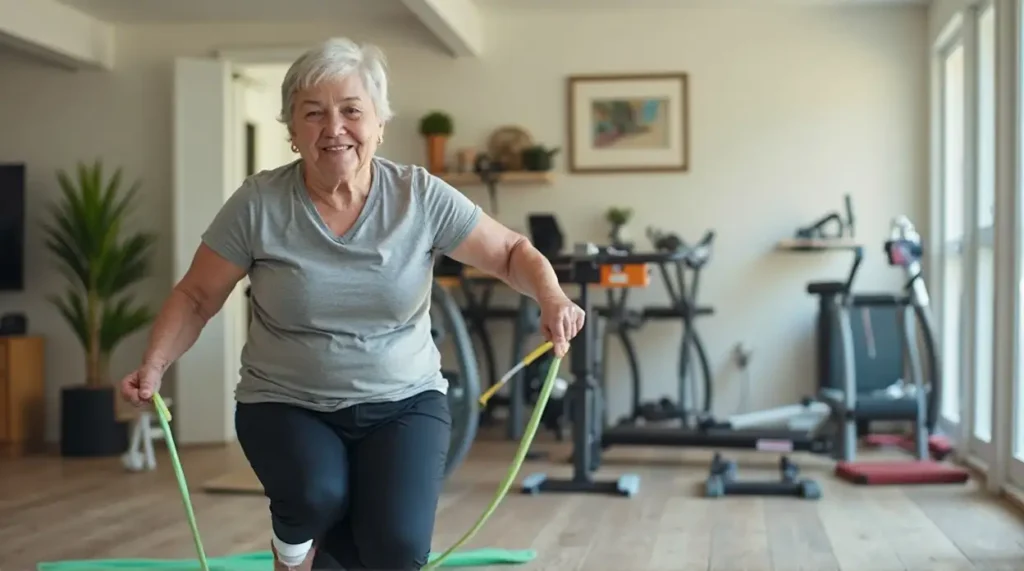What if the meals you eat each day could decide how strong, sharp, and independent you stay? For seniors, food is no longer only about taste—it is the foundation of health. The right balance of meals can help protect memory, keep energy steady, and prevent illness. The problem is, many seniors are not sure what “balanced meals” actually mean for them today.
Aging changes the body in many ways. Muscles need more support. Bones need more strength. The immune system needs more care. Eating the same way as before may not give your body what it needs now. That is why a simple guide to daily nutrition is so important. It can help you eat with purpose and stay in control of your health.
You may already know that nutrition matters, but balance means something different for seniors. Meals should not only fill you up—they should fuel you with exactly what your body is asking for. In this guide, you will see how easy it is to build balanced meals step by step.
What a Balanced Plate Looks Like
A balanced meal for seniors includes four main parts:
- Protein for strength
- Fruits and vegetables for vitamins and minerals
- Whole grains for energy
- Healthy fats for heart and brain health
The payoff comes when all four parts are on your plate together. Your body works better when these groups are balanced, not when one group takes over. Many seniors skip protein or eat fewer vegetables, which slowly weakens the body. Adding balance back makes every bite work harder for you.
Here’s a simple way to picture it: half the plate should be fruits and vegetables, one-quarter protein, and one-quarter whole grains, with a spoon of healthy fat added in. This is not a diet plan—it is a steady way to make sure every meal counts.
The Nutrients That Protect Seniors
Now that you know what a balanced plate looks like, it is time to dig deeper. Balance is about more than food groups—it is about the nutrients inside them. For seniors, certain nutrients matter more than ever. If they are missing, problems can build up quietly. But when you get enough, they protect your strength, memory, and independence.
Protein for Muscles and Energy
Muscle loss is a natural part of aging, but it does not have to take away your freedom. Without enough protein, this process speeds up, leaving you weaker, tired, and more likely to fall. The key is to feed your muscles every single day. Eggs, chicken, fish, beans, lentils, tofu, and low-fat dairy are excellent sources.
One mistake many seniors make is eating most of their protein at dinner. The body absorbs it better when spread across the day. For example, start breakfast with eggs or Greek yogurt, have beans or tuna at lunch, and enjoy poultry or fish at dinner. This steady supply keeps muscles strong and gives your body energy all day.
Calcium and Vitamin D for Strong Bones
Your bones are always changing, even in later years. Aging makes them thinner and weaker, raising the risk of fractures from falls. That is why calcium and vitamin D are vital. Calcium builds bone strength, and vitamin D helps the body absorb it. Without enough of both, bones lose their structure faster.
Dairy foods, fortified plant milks, canned salmon with bones, almonds, and leafy greens such as kale are good sources of calcium. For vitamin D, sunlight is helpful, but seniors absorb it less efficiently. That is why fortified foods and sometimes supplements are needed. Talk with your doctor before starting supplements, especially if you take medications.
Fiber for Digestion and Health
Constipation is one of the most common problems for seniors. Slower digestion, less movement, and certain medications all play a role. Fiber is the solution. It helps food move smoothly through the digestive system, keeps blood sugar steady, and supports a healthy weight.
Whole grains, beans, vegetables, fruits, and nuts are fiber-rich. Aim to add them to every meal instead of getting fiber all at once. For example, oatmeal at breakfast, vegetables and beans at lunch, and whole grain bread at dinner make a big difference. But remember—fiber only works when you drink enough water. Without water, it can make constipation worse.
Healthy Fats for the Brain and Heart
Fats get a bad reputation, but the right ones are essential. Healthy fats protect your heart, keep cholesterol in balance, and support brain health. They also help the body absorb vitamins A, D, E, and K. Missing healthy fats can leave your body less protected against memory decline and heart problems.
The best sources are olive oil, nuts, seeds, avocados, and fatty fish such as salmon or sardines. These fats are anti-inflammatory and protective. In contrast, fried foods, processed snacks, and trans fats do harm and should be limited. Adding just a spoon of olive oil to vegetables, or a handful of nuts as a snack, gives your body the fats it needs daily.
Beyond these four, some other nutrients deserve attention:
- Vitamin B12: Needed for energy, memory, and healthy nerves. Seniors absorb less from food, so fortified cereals or supplements may be required.
- Potassium: Helps control blood pressure. Found in bananas, oranges, potatoes, and beans.
- Magnesium: Supports muscles, nerves, and sleep. Found in nuts, seeds, and whole grains.
- Iron: Prevents tiredness and weakness. Found in lean meats, beans, and leafy greens.
Each of these nutrients acts like a shield. Without them, the body weakens faster. With them, you stay stronger, more focused, and more independent.
The body absorbs less vitamin B12 with age. Low B12 causes weakness, poor memory, and nerve pain. B12 is in animal products, so seniors who eat less meat may need fortified foods or supplements. Vitamin B6 also helps brain and nerve function and can be found in poultry, bananas, and potatoes.
Each of these nutrients acts as a guard. When missing, health problems show up fast. Balanced meals protect you before these problems begin.
Turning Balance Into Daily Action
Knowing what to eat is powerful, but the real benefit comes when it becomes part of daily life. Many seniors find it hard to plan meals, shop for the right foods, or cook regularly. The good news is that balanced eating does not have to be complicated. Small steps make a big difference. Here are simple ways to turn balance into action.
Meals do not need to be fancy. A few basic ingredients can be turned into balanced plates. For breakfast, try oatmeal topped with berries and a spoon of yogurt. For lunch, a tuna or egg sandwich on whole grain bread with sliced vegetables works well. For dinner, grilled chicken with brown rice and steamed broccoli drizzled with olive oil gives your body everything it needs.
Planning a week of meals in advance can reduce stress and prevent skipped meals. Writing down three to four easy options for each meal helps you stay on track. A short shopping list built around these meals saves time and energy at the store.
Aging bodies need fewer calories than before, but the need for vitamins and minerals does not go down. That means the focus should be on nutrient-rich foods in smaller amounts. Filling the plate with vegetables and protein first, and then adding whole grains, is a simple way to keep portions balanced.
Using smaller plates can help naturally control portions. Pay attention to hunger and fullness signals. Eating slowly and enjoying each bite helps you notice when you are satisfied without overeating.
Snacks are more than just something to pass the time. They are a chance to add nutrition and steady your energy. Instead of chips or sweets, choose snacks that give protein, fiber, or healthy fats. Cheese with whole grain crackers, apple slices with peanut butter, a small bowl of yogurt with fruit, or a handful of nuts are excellent choices.
Balanced snacks also prevent dips in blood sugar, which can cause tiredness or dizziness. Keeping healthy snacks ready in small containers makes it easier to choose them over less nutritious options.
Thirst signals weaken with age, which means many seniors drink less water without realizing it. Dehydration leads to confusion, low energy, and kidney strain. That is why sipping water throughout the day is critical. Aim for small, steady drinks instead of trying to take in large amounts at once.
If plain water feels boring, herbal teas, soups, or water-rich fruits like watermelon and cucumber are helpful. Keeping a water bottle nearby serves as a reminder. Setting a timer or marking water levels on a bottle can make it easier to track intake.
Cooking every day can feel draining. Batch cooking saves both time and effort. Making a pot of vegetable soup, roasting a tray of vegetables, or cooking a large portion of brown rice can cover several meals. These foods can be stored in the fridge and used in different combinations.
For example, roasted vegetables can be eaten with chicken one day, added to a salad the next, and mixed into a soup later. Cooking this way reduces kitchen work and makes balanced meals more convenient.
A colorful plate is a powerful signal of good nutrition. Different colors in fruits and vegetables provide different vitamins and minerals. Green broccoli gives calcium and vitamin K, orange carrots provide vitamin A, red tomatoes give vitamin C, and purple berries protect memory with antioxidants.
Making sure half of the plate is filled with colorful produce at each meal ensures variety without needing to memorize nutrient charts. Shopping with color in mind—picking at least three different colors of produce—makes eating balanced meals simple and fun.
The key to success is not perfection. It is consistency. Every small change builds strength over time. Adding an extra serving of vegetables, drinking more water, or replacing one processed snack with a healthy one all move you forward.
Balanced eating is not a sudden shift but a steady habit. When meals follow this simple structure, the body feels stronger, the mind feels clearer, and the effort pays off in daily life. This is where knowledge turns into action—and action turns into lasting health.
Balanced meals are not about strict rules or giving up food you enjoy. They are about building meals that support your body now, in this stage of life. With balance, you can feel stronger, protect memory, and stay more independent.
The journey starts with small steps: more vegetables on your plate, more protein in the morning, more water through the day. The reward is not only better health but also more energy to live life fully.
Every meal is a chance to give your body what it truly needs. You now have the guide—protein, grains, fruits, vegetables, healthy fats, and key nutrients. Put them together, one meal at a time. Balance is not a burden. It is your tool for staying active, sharp, and ready for the years ahead.




